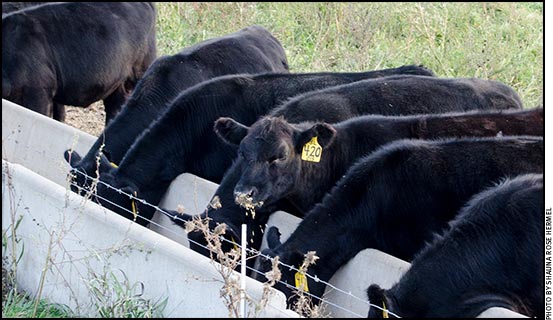
Feeding Newly Weaned Calves
K-State specialist gives tips to improve feed consumption by newly weaned calves.
As spring beef calves are beginning to be weaned, it is the producer’s responsibility to help make that transition as smooth as possible. Improper weaning can result in poor growth, which may stay with the animal throughout its life, according to Kansas State University (K-State) animal scientist Justin Waggoner.
“I break down the weaning process into three stresses the calf is dealing with,” said Waggoner, who is a beef systems specialist with K-State Research and Extension. The first and most obvious is maternal separation; the second is moving to a new environment and social structure; the third is the need for a calf to become accustomed to new and unfamiliar feedstuffs as it’s transitioned from a diet of grass and milk to a total mixed ration or starter pellet in a different environment.
He provided tips to help ease the transition.
- Many calves are raised in a grassland environment. Getting them adjusted to a feedbunk is one of the most important things a producer can do in the weaning process. If they do not eat properly, there’s an increased risk of disease.
- Feeding both cows and calves a small amount of a supplement or the weaning ration out of a bunk prior to weaning when the calves are with the cows can be a good way to acclimate them to those feeds. The cows may consume most of the feed, but the calves are up there getting exposed to the bunk.
A study at the K-State Agricultural Research Center at Hays showed that where calves had exposure to a feedbunk, either through a drylot or pasture method, a higher percentage of them approached and ate from the bunk in the critical first week of weaning than calves that had never been exposed to a feedbunk before, Waggoner said.
“The results tell us previous exposure to the feedbunk really matters,” he added. “This is especially important as newly weaned calves are brought into a typical feedlot environment or even a set of pens. Just that adjustment can help in making that successful transition from being at their mother’s side to being in a different environment.”
The ration
Waggoner referenced a series of studies called the K-State Hays weaning feed management protocol, a step-by-step process used to wean calves so it would be standardized across different treatment groups. It transitioned the calves from a grass and milk diet to some sort of a total mixed ration.
Weanlings are often accustomed to feedstuffs such as grass and hay, which are not rich in nutrients, so producers must find a way to balance the familiar feedstuff with new, nutrient-rich feeds.
The dry-matter intake (DMI) on calves is often about 1% of body weight, Waggoner said. The Hays protocol suggests that producers offer the calf 0.5% of its body weight of concentrate-based 75%- to 85%-TDN (total digestible nutrient) ration. Try to limit silage and other familiar feeds. So, the calf is offered half of 1.0% or 0.5% of body weight of a weaning ration or pellet and half of 1% of body weight of good-quality grass hay.
- Positioning the feed is as important as the feed itself. Put the hay the calves are most familiar with on top of the feed ration on the first day.
- The second day the ration should be increased to around 0.7% of the body weight and keep the hay the same. Put the hay on top of the ration.
- On the third or fourth day, increase the amount of feed, but not the hay. At this time, put the ration on top of the hay.
- Days seven through 10 of weaning, the goal is to have a calf eating 2% to 2.2% of its body weight — maybe even 2.5%.
“We are trying to build a transition into the calves as they move into new feeding rations in a stabilized way,” said Waggoner, noting that this regimen balances the need to transition the calves and ensure they have enough nutrition. Often weanling calves are fed as much as they will eat, which can lead to problems later.
“It is important to keep the calves eating because there are many times where we create more problems for ourselves in a weaning program by getting ahead of the calves and offering them too much feed,” Waggoner said. “The calves eat really strong one day and then the next day they back off and the intakes go up and down.”
Make sure calves are effectively prepared for the weaning transition, he said. Adequately preparing them to make that transition should pay back in terms of health and the ultimate lifetime performance of that calf as it moves to the next phase of the production cycle.
Editor’s Note: A National Junior Angus Association member, Connor Orrock is a junior at Kansas State University studying agriculture communications and journalism.







